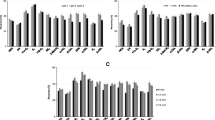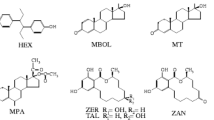Abstract
Within this study, a new method enabling monitoring of various estrogenic substances potentially occurring in milk and dairy products was proposed. Groups of compounds fairly differing in physico-chemical properties and biological activity were analyzed: four natural estrogens, four synthetic estrogens, five mycoestrogens, and nine phytoestrogens. Since they may pass into milk mainly in glucuronated and sulfated forms, an enzymatic hydrolysis was involved prior to the extraction based on the QuEChERS methodology. For the purification of the organic extract, a dispersive solid-phase extraction (d-SPE) with sorbent C18 was applied. The final analysis was performed by ultra-high-performance liquid chromatography (UHPLC) coupled with triple quadrupole tandem mass spectrometry (MS/MS). Method recovery ranged from 70 to 120% with a relative standard deviation (RSD) value lower than 20% and limits of quantification (LOQs) in the range of 0.02–0.60 μg/L (0.2–6.0 μg/kg dry weight) and 0.02–0.90 μg/kg (0.2–6.0 μg/kg dry weight) for milk and yogurt, respectively. The new procedure was applied for the investigation of estrogenic compounds in 11 milk samples and 13 yogurt samples from a Czech retail market. Mainly phytoestrogens were found in the studied samples. The most abundant compounds were equol and enterolactone representing 40–90% of all estrogens. The total content of phytoestrogens (free and bound) was in the range of 149–3870 μg/kg dry weight. This amount is approximately 20 times higher compared to non-bound estrogens.



Similar content being viewed by others
References
Albertazzi P, Purdie DW. The nature and utility of the phytoestrogens: a review of the evidence. Maturitas. 2002;42:173–85.
Fritsche S, Steinhart H. Occurrence of hormonally active compounds in food: a review. Eur Food Res Technol. 1999;209:153–79.
EFSA Scientific Committee. Scientific opinion on the hazard assessment of endocrine disruptors: scientific criteria for identification of endocrine disruptors and appropriateness of existing test methods for assessing effects mediated by these substances on human health and the environment. EFSA J. 2013;11:3132. doi:10.2903/j.efsa.2013.3132.
Gibson DA, Saunders PT. Endocrine disruption of oestrogen action and female reproductive tract cancers. Endocr Relat Cancer. 2014;21:T13–31.
Malekinejad H, Scherpenisse P, Bergwerff AA. Naturally occurring estrogens in processed milk and in raw milk (from gestated cows). J Agric Food Chem. 2006;54:9785–91.
Tso J, Aga DS. A systematic investigation to optimize simultaneous extraction and liquid chromatography tandem mass spectrometry analysis of estrogens and their conjugated metabolites in milk. J Chrom A. 2010;1217:4784–95.
Giusti MR, Iwamoto, Hatch EE. Diethylstilbestrol revisited: a review of the long-term health effects. Ann Intern Med. 1995;122:778–88.
Council Directive 96/23/EC. Off J Eur Comm. 1996;L125(1996):10.
Kalac P. Fresh and ensiled forages as a source of estrogenic equol in bovine milk: a review. Czech J Anim Sci. 2013;58:296–303.
Höjer A, Adler S, Purup S, Hansen-Møller J, Martinsson K, Steinshamn H, Gustavsson AM. Effects of feeding dairy cows different legume-grass silages on milk phytoestrogen concentration. J Dairy Sci. 2012;95:4526–40.
Njåstad KM, Adler SA, Hansen-Møller J, Thuen E, Gustavsson AM, Steinshamn H. Gastrointestinal metabolism of phytoestrogens in lactating dairy cows fed silages with different botanical composition. J Dairy Sci. 2014;97:7735–50.
Daems F, Romnee JM, Heuskin S, Froidmont É, Lognay G. Analytical methods used to quantify isoflavones in cow’s milk: a review. Dairy Sci Technol. 2016;96:261–83.
Wocławek-Potocka I, Mannelli C, Boruszewska D, Kowalczyk-Zieba I, Waśniewski T, Skarżyński DJ. Diverse effects of phytoestrogens on the reproductive performance: cow as a model. Int J Endocrinol. 2013;2013:1–15.
Becker-Algeri TA, Castagnaro D, de Bortoli K, de Souza C, Drunkler DA, Badiale-Furlong E. Mycotoxins in bovine milk and dairy products: a review. J Food Sci. 2016;81:544–52.
Kalac P. The effects of silage feeding on some sensory and health attributes of cow’s milk: a review. Food Chem. 2011;125:307–17.
Meucci V, Soldani G, Razzuoli E, Saggese G, Massart F. Mycoestrogen pollution of Italian infant food. J Pediatr. 2011;159:278–83.
Signorini ML, Gaggiotti M, Molineri A, Chiericatti CA, Zapata de Basílico ML, Basílico JC, Pisani M. Exposure assessment of mycotoxins in cow’s milk in Argentina. Food Chem Toxicol. 2012;50:250–7.
Huang LC, Zheng N, Zheng BQ, Wen F, Cheng JB, Han RW, Xu XM, Li SL, Wang JQ. Simultaneous determination of aflatoxin M1, ochratoxin A, zearalenone and α-zearalenol in milk by UHPLC–MS/MS. Food Chem. 2014;146:242–9.
Adamusova H, Bosakova Z, Coufal P, Pacakova V. Analysis of estrogens and estrogen mimics in edible matrices—a review. J Sep Sci. 2014;37:885–905.
Capriotti AL, Cavaliere C, Colapicchioni V, Piovesana S, Samperi R, Laganà A. Analytical strategies based on chromatography–mass spectrometry for the determination of estrogen-mimicking compounds in food. J Chrom A. 2013;1313:62–77.
Socas-Rodríguez B, Asensio-Ramos M, Hernández-Borges J, Herrera-Herrera AV, Rodríguez-Delgado M. Chromatographic analysis of natural and synthetic estrogens in milk and dairy products. TrAC Trend Anal Chem. 2013;44:58–77.
Capriotti AL, Cavaliere C, Foglia P, Samperi R, Stampachiacchiere S, Ventura S, Laganà A. Ultra-high-performance liquid chromatography-tandem mass spectrometry for the analysis of free and conjugated natural estrogens in cow milk without deconjugation. Anal Bioanal Chem. 2015;407:1705–19.
Cavaliere C, Capriotti AL, Foglia P, Piovesana S, Samperi R, Ventura S, Laganà A. Natural estrogens in dairy products: determination of free and conjugated forms by ultra high performance liquid chromatography with tandem mass spectrometry. J Sep Sci. 2015;38:3599–606.
Capriotti AL, Cavaliere C, Piovesana S, Stampachiacchiere S, Samperi R, Ventura S, Laganà A. Simultaneous determination of naturally occurring estrogens and mycoestrogens in milk by ultrahigh-performance liquid chromatography–tandem mass spectrometry analysis. J Agric Food Chem. 2015;63:8940–6.
D’Orazio G, Asensio-Ramos M, Hernández-Borges J, Rodríguez-Delgado M, Fanali S. Evaluation of the combination of a dispersive liquid–liquid microextraction method with micellar electrokinetic chromatography coupled to mass spectrometry for the determination of estrogenic compounds in milk and yogurt. Electrophoresis. 2015;36:615–25.
Wielogórska E, Elliott CT, Danaher O, Chevallier O, Connolly L. Validation of an ultra high performance liquid chromatography–tandem mass spectrometry method for detection and quantitation of 19 endocrine disruptors in milk. Food Control. 2015;48:48–55.
Anastassiades M, Lehotay SJ, Štajnbaher D, Schenck FJ. Fast and easy multiresidue method employing acetonitrile extraction/partitioning and dispersive solid-phase extraction for the determination of pesticide residues in produce. J AOAC Int. 2003;86:412–31.
Ehling S, Reddy TM. Liquid chromatography–mass spectrometry method for the quantitative determination of residues of selected veterinary hormones in powdered ingredients derived from bovine milk. J Agric Food Chem. 2013;61:11782–91.
ČSN ISO 6731 (2011). Milk, cream and evaporated milk—determination of total solids content (reference method). This standard is the Czech version of the International Standard ISO 6731:2010.
ČSN ISO 13580 (2007). Yogurt—determination of total solids content (reference method). This standard is the Czech version of International Standard ISO 13580:2005.
Lankova D, Lacina O, Pulkrabova J, Hajslova J. The determination of perfluoroalkyl substances, brominated flame retardants and their metabolites in human breast milk and infant formula. Talanta. 2013;117:318–25.
Sapozhnikova Y, Lehotay SJ. Multi-class, multi-residue analysis of pesticides, polychlorinated biphenyls, polycyclic aromatic hydrocarbons, polybrominated diphenyl ethers and novel flame retardants in fish using fast, low-pressure gas chromatography–tandem mass spectrometry. Anal Chim Acta. 2013;758:80–92.
Rajski Ł, Lozano A, Uclés A, Ferrer C, Fernández-Alba AR. Determination of pesticide residues in high oil vegetal commodities by using various multi-residue methods and clean-ups followed by liquid chromatography tandem mass spectrometry. J Chromatogr A. 2013;1304:109–20.
Lozano A, Rajski Ł, Uclés S, Belmonte-Valles N, Mezcua M, Fernández-Alba AR. Evaluation of zirconium dioxide-based sorbents to decrease the matrix effect in avocado and almond multiresidue pesticide analysis followed by gas chromatography tandem mass spectrometry. Talanta. 2014;118:68–83.
Herrero P, Borrull F, Pocurull E, Marcé RM. A quick, easy, cheap, effective, rugged and safe extraction method followed by liquid chromatography-(Orbitrap) high resolution mass spectrometry to determine benzotriazole, benzothiazole and benzenesulfonamide derivates in sewage sludge. J Chromatogr A. 2014;1339:34–41.
Rubert J, León N, Sáez C, Martins CPB, Godula M, Yusá V, Mañes J, Soriano JM, Soler C. Evaluation of mycotoxins and their metabolites in human breast milk using liquid chromatography coupled to high resolution mass spectrometry. Anal Chim Acta. 2014;820:39–46.
Jia W, Chu X, Ling Y, Huang J, Chang J. Multi-mycotoxin analysis in dairy products by liquid chromatography coupled to quadrupole orbitrap mass spectrometry. J Chromatogr A. 2014;1345:107–14.
Antignac JP, Cariou R, Le Bizec B, André F. New data regarding phytoestrogens content in bovine milk. Food Chem. 2004;87:275–81.
Tsen SY, Siew J, EKL L, bte Roslee FA, Chan HM, Loke WM. Cow’s milk as a dietary source of equol and phenolic antioxidants: differential distribution in the milk aqueous and lipid fractions. Dairy Sci Technol. 2014;94:625–32.
Hoikkala A, Mustonen E, Saastamoinen I, Jokela T, Taponen J, Saloniemi H, Wähälä K. High levels of equol in organic skimmed Finnish cow milk. Mol Nutr Food Res. 2007;51:782–6.
Courant F, Antignac JP, Laille J, Monteau F, Andre F, Le Bizec B. Exposure assessment of prepubertal children to steroid endocrine disruptors. 2. Determination of steroid hormones in milk, egg, and meat samples. J Agric Food Chem. 2008;56:3176–84.
Qin LQ, Wang PY, Kaneko T, Hoshi K, Sato A. Estrogen: one of the risk factors in milk for prostate cancer. Med Hypotheses. 2004;62:133–42.
Acknowledgements
B.S.R. would like to thank the Canary Agency of Economy, Industry, Trade and Knowledge of the Government of the Canary Islands for the FPI fellowship (co-financed with 85% from European Social Funds). This work was supported by the Operational Programme Prague—Competitiveness (CZ.2.16/3.1.00/21537 and CZ.2.16/3.1.00/24503) and by the “National Program of Sustainability I”—NPU I (LO1215 and LO1601).
Author information
Authors and Affiliations
Corresponding author
Ethics declarations
Conflict of interest
The authors declare that they have no competing interests.
Electronic supplementary material
ESM 1
(PDF 184 kb)
Rights and permissions
About this article
Cite this article
Socas-Rodríguez, B., Lanková, D., Urbancová, K. et al. Multiclass analytical method for the determination of natural/synthetic steroid hormones, phytoestrogens, and mycoestrogens in milk and yogurt. Anal Bioanal Chem 409, 4467–4477 (2017). https://doi.org/10.1007/s00216-017-0391-x
Received:
Revised:
Accepted:
Published:
Issue Date:
DOI: https://doi.org/10.1007/s00216-017-0391-x




